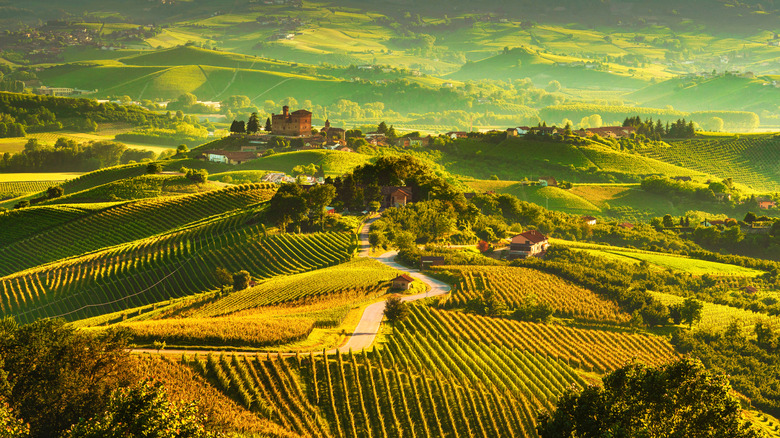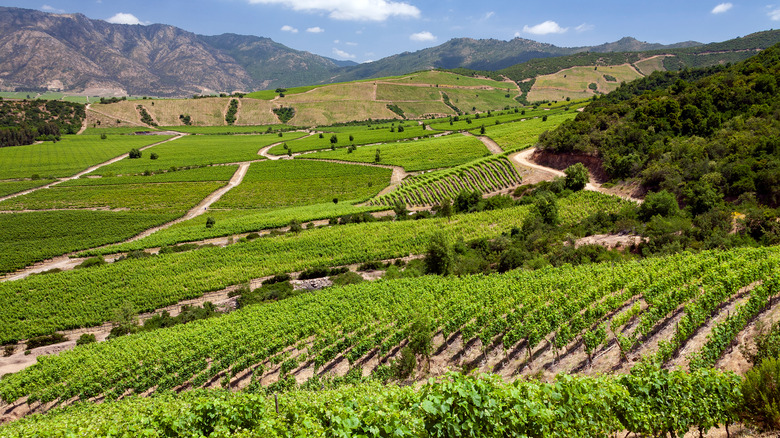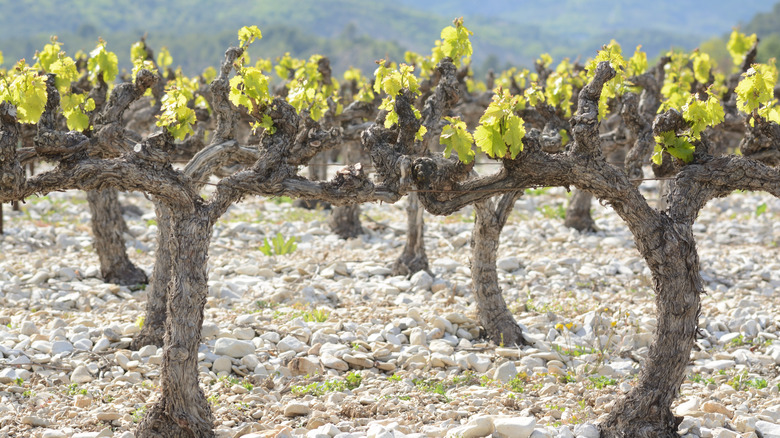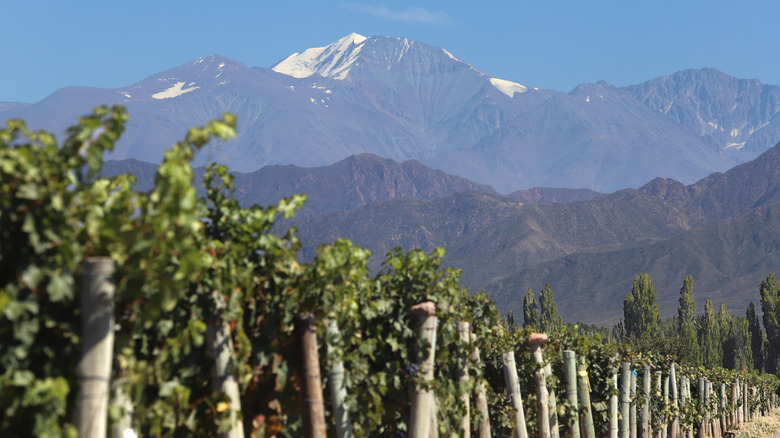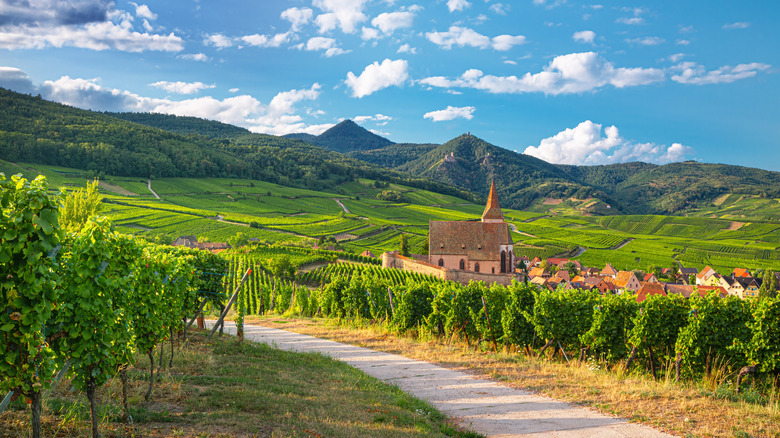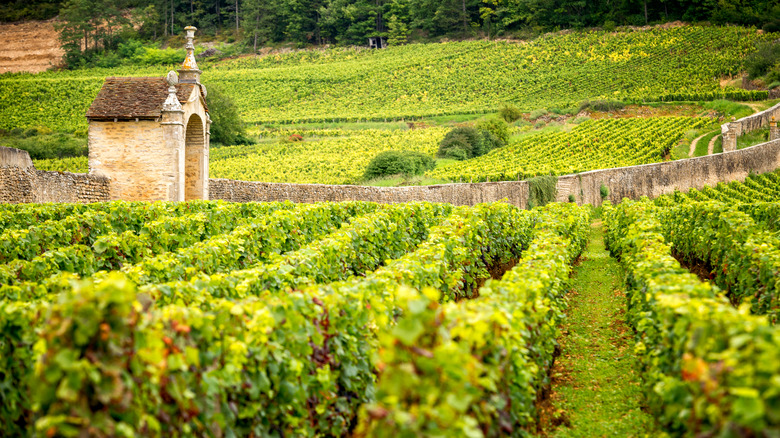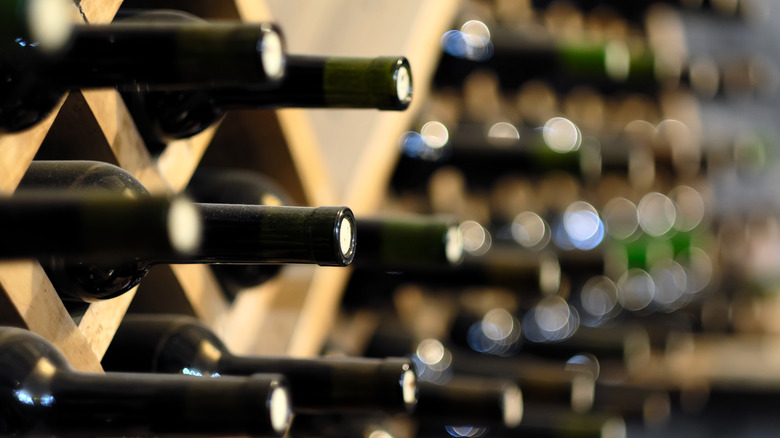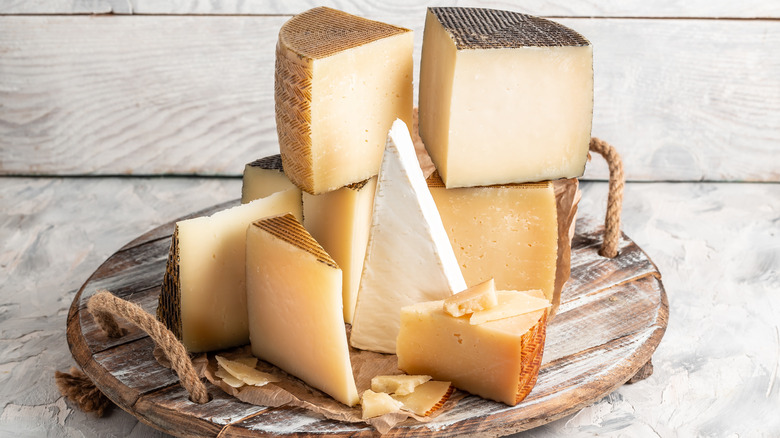What Does Terroir Mean And Is It Actually Important?
Sometimes it seems like any discussion regarding wine is filled with vocabulary in foreign languages or concepts that require a great deal of context (or even a university degree to understand). It's easy to think that wine experts are just adding barriers for normal folks to chat about vino, but a lot of the notions have been around for ages. While some terms have been extensively used to describe flavors and aromas in wine, others have been coined to depict a picture of the places where the wine grapes are grown.
Although the average consumer might not know that the same grape variety will taste different, depending on where it is grown, wine professionals have not only asserted this fact but have created hierarchies and systems to designate each area in particular. So, those magician-like blind tasters that appear to be able to locate the origin of a wine down to its specific row in a vineyard — they're generally relying on a concept known as terroir, an ideology that might appear as hard to pinpoint as the results of a blind taste test.
What exactly is terroir?
According to Wine Folly, the simplest way to define the concept of terroir is "how a particular region's climate, soils, and aspect (terrain) affect the taste of wine." The term hails from the Latin word "terre" or "territoire," and Earth Magazine indicates that terroir can be interpreted as "a stretch of land limited by its agricultural capacity." The source also notes that the definition is broad and can include climate, soil, and geography — not to mention culture, tradition, and local agricultural methods. Not only does this term define what practices are common in an area of growing, but it's also assumed to be expressed in the regional products.
Wine growers have taken the concept far and wide, according to Earth Magazine, and in 1935 in France there was a categorization system that was developed with the acronym AOC. Guidelines and laws regarding what could be grown in a designated area, as well as permitted winemaking methods, were declared under this header. Earth Magazine remarks that similar classifications are now used in numerous countries, such as American Viticultural Areas (AVAs). These groupings are meant to assert authenticity, which MasterClass suggests might have been a preoccupation to France. The source explains that in the 1800s, when a pest wiped out most vineyards across Europe, French vines had to be grafted onto the roots of American vines. This might have led the French to seek ways to define how their own land influenced the resulting product.
Countless essays, debates, and scientific research have sought to further identify the notion of terroir, but the most consistent view is that there is an underlying elusive element of mystique that can't quite be understood. Perhaps it's what gives some wines their mythical status — and the prices to match.
How is climate involved in terroir?
Climate is high on the list of factors that affect the terroir quotient in wine. First, as with any fruit, grapes ripen more quickly and fully in hotter climates. A Matter of Taste reports this type of climate leads to increased sugar and alcohol content, and a fuller-bodied wine compared with cooler climate grapes, which tend to produce crisp, high acid, lower alcohol wines. You don't have to be a wine expert to notice the difference between a white varietal brimming with tropical fruit flavors and another with notes of citrus and a puckering acidity.
Grapes also have fluctuating growing seasons, which means that some varieties are best harvested in specific climates for the most success. As Earth Magazine reports, different regions have distinct temperatures, which are often ideal for certain grapes, hence why some can only grow in specific areas of the world. Regardless of climate, Sommelier Business points out that winemakers choose when to harvest their grapes based on the features they want the resulting wine to have. Therefore, climate and human intervention cooperate for the ideal set of characteristics.
Ongoing changes in climate mean that wine regions must also rethink which grapes they will grow as temperatures shift (via Wine Investment). A region that was once favorable for cooler climate grapes might soon need to adapt to suit the ever-changing environmental conditions. Wine Investment suggests that these alterations will actually have a benefit, resulting in new styles that define a region's terroir.
Is the type of soil important?
Unlike other crops that require fertile soil, vines thrive in infertile land, made of rocks, sand, and organic matter (via Vivino). While some people swear that their wine tastes of limestone, slate, granite, and other materials, geologist Alex Maltman indicates that there is no proof that any components from the soil can find their way into flavors in wine (via Journal of Wine Research). Furthermore, he reports that most rocks and stones simply have no flavor. Even if they did, it is likely impossible to objectively measure taste, making a conclusive result rather unlikely.
Nevertheless, there is certainly some aspect of soil that is reflected in wine, whether you can pinpoint the taste or not. Much like climate, Earth Magazine remarks that grapes have preferred soils due to features such as water retention and heat absorption, both which can affect factors like the concentration of flavors.
Aside from water and minerals, Food & Wine points out that fungi and bacteria in the soil undoubtedly have an effect on terroir, too. The source notes that natural yeast from grapes produces different flavors and characteristics depending on the microbial content. These unique flavors are emphasized in natural wines. Similarly, Sommelier Business suggests that these components represent the biogeographic footprint of a given piece of land.
Altogether, these aspects of soil point to a specific location, parallel to the notion that terroir involves features that can't be obtained anywhere else.
What role does topography and landscape play?
Soil is of course important to terroir since vines are planted in it, but A Matter of Taste remarks that other aspects of the land, such as changes in elevation and the direction of slopes, are also significant. These components work together with climate and soil, resulting in unique characteristics that affect wine.
Take elevation, for example: Some vines are practically seaside whereas others are found on mountainsides. According to A Matter of Taste, vineyards at higher altitudes experience larger differences between daytime and nighttime temperatures, also known as diurnal shifts. The source explains that this permits the grapes to ripen from the warm daytime sun and maintain their acidity at night when temperatures cool down.
Vines do well on sloped terrain due to sun exposure, wind protection, and the creation of microclimates, according to Vinepair. The source explains that slopes facing south and west generally receive more sun in the northern hemisphere. While this can be useful in regions with cooler climates, vineyards in hotter regions can benefit from slopes facing north or east.
Additionally, surrounding landscape such as forests, coasts, mountains, and large bodies of water all contribute to the climate and characteristics of a place. And all of these factors are unique to a vineyard, ultimately contributing to its specific terroir.
What history and tradition tell us about terroir
In Europe, winemaking and viticulture have long been connected to history and tradition. Vines grew naturally in specific regions, contributing to agriculture and business. Outside of Europe, terroir is more of a strategic choice since vines have been planted with the intention of maximizing their optimal environment (via Earth Magazine).
Food & Wine remarks that it can come down to the old nature vs. nurture debate: Some people claim that nature is solely responsible for terroir, while others agree there is an interplay between human intervention and the natural characteristics of a region. Furthermore, farming methods and winemaking techniques are usually included in European classification laws, influencing the resulting style of the wine. As well, winemakers harvest their grapes based on tradition and climate, which can have a significant difference on the final result.
Historically, certain wine regions have stood out thanks to their role in ancient civilizations, and the presence of church or royalty (via Arena Flowers). In Bordeaux, France, for example, its famous system of classifications (aka growths), came about upon the request of Emperor Napoleon III in 1855, according to Wine Spectator. To this day, the most acclaimed vineyards still maintain their position in the hierarchy. Over in Burgundy, Bourgogne Wines remarks that King Louis XVI's doctor recommended that he drink the local wine for health. The trend continued among the aristocracy, ultimately raising Burgundy's status. The majority of notable wine regions in the world have their own share of stories like this indicating the value of their terroir.
Wine countries known for their terroir
Regions in the world known for the quality of their wine are usually also known for their terroir. While countries like France and Italy are considered to produce excellent wine, there is certainly a hierarchy for the best regions. France is home to some of the most prestigious wines in the world, including Champagne, Burgundy, and Bordeaux (via My Global View). Nevertheless, a multitude of elements are at play when it comes to declaring one region or another as the best. This was proven at The Judgment of Paris in 1976, when California wines won against their French competitors (via Wine Spectator). Terroir was no longer only the result of centuries of European tradition, but also was becoming present in the New World.
In Italy, Tuscany is by far one of the country's most prized wine regions, with gentle rolling hills, some elevation, and temperate climate — all a perfect match for the wine produced, according to wine writer Jancis Robinson. Likewise, Barolo, Piedmont has a notable terroir and even received UNESCO status thanks to its impressive qualities and history (via World Heritage Convention). According to Decanter, numerous other vineyard regions across Europe have been deemed worthy of UNESCO status. Sites include Burgundy, Champagne, Portugal's Douro Valley, and Wachau in Austria to name a few. While the UNESCO designation is certainly noteworthy, it can also lead to increased wine prices. But here's a tip: Look for wines from surrounding areas that can also reflect the prized characteristics, but perhaps at a more affordable cost.
Can terroir affect the price of wine?
As mentioned, the concept of terroir implies the identification of authenticity to a specific region. Wine that expresses terroir fits into a set of characteristics perceived to be typical of a certain location — also known in wine speak as typicity. Consequently, regions that have received praise for their wine are regarded highly on the whole spectrum, and this perceived quality and status can ultimately be reflected in the price.
Wines from the best vineyards in Burgundy, France regularly sell for thousands of dollars, says I Like This Grape. Perhaps unsurprisingly, the monks who first tended to the vineyards in Burgundy were quite fond of the concept of terroir, according to Earth Magazine. The source reports that Burgundy has continued to promote the notion for marketing purposes, simultaneously boosting tourism and sales. At 1.8 hectares of size, Domaine de la Romanée-Conti (DRC for those in the know), is among the most prestigious vineyards in the world (via Earth Magazine). The cost of a single bottle from here is around $20,000, according to Vinepair, but you'll need more than money to get your hands on these exclusive bottles.
While a portion of wines are highly esteemed for their terroir, Wine and Other Stories remarks that large volumes of affordable wine are also made worldwide with the aim of producing a consistent flavor over time, regardless of climate, geography, and tradition.
Here's how to taste-test terroir
If you're keen to explore the world of wine with terroir in mind, there are many ways you can choose wines to highlight certain features. If you're not ready to do much research, bottle labels already contain clues about the geography, alluding to coasts or elevation, as well as to soil and winemaking techniques.
For starters, trying the same grape from different regions in the world is a good introduction to terroir. Tasting a Pinot Noir from sunny California will be distinct from one from Burgundy with its cooler climate. Next, you could try different grape varieties grown in the same region to taste the influence of a specific terroir on the fruit.
Another point of focus could be to taste different wines from mountainous regions to see the effect of elevation. The same could be done for coastal regions, vineyards close to volcanoes, or those in extremely arid dry climates. As Wine Cooler Direct notes, making a point to taste a wine after learning more about its terroir can make certain elements more salient — and might even help you determine which varietal you like best.
Does terroir only relate to wine characteristics?
Although wine comes up a fair deal when talking about terroir, the concept is not limited to just this drink. Since terroir describes a sense of place, other products that might be able to impart characteristics from the land on which they are grown are also relevant.
Cheese isn't just a classic pairing with wine, it also manages to express features of its terroir, too. While Kraft Singles can't quite be described as a product of terroir, French Food in the US remarks that Roquefort cheese certainly can. The site explains that Roquefort cheese conveys the particular flora of an area, as well as the regional know-how of previous generations. Together, these characteristics represent the terroir of the region. Similarly, Culture Cheese Mag points out that cheese tastes the way it does thanks to the grass the animals eat, as well as bacteria in the soil and the humidity, again all factors of terroir.
Aside from cheese and wine, A Matter of Taste points out that rum, chocolate, coffee, and tomatoes are among other items that express terroir. And seafood is applicable too, though it has its own like term called merroir.
